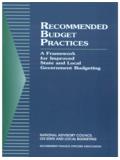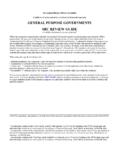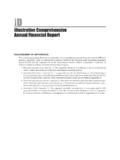Transcription of Recommended Budget Practices
1 Recommended Budget Practices :A Framework For Improved Stateand Local Government Budgeting national Advisory Council on State and Local BudgetingGovernment Finance Officers AssociationMEMBERS OF THE national ADVISORY COUNCIL ON STATE AND LOCAL BUDGETINGA ssociation of School Business Officials International Don I. Tharpe, Executive Director, Association of School Business Officials International Denny G. Bolton, Business Administrator, Owen J. Roberts School District, PennsylvaniaCouncil of State Governments Douglas B. Roberts, State Treasurer, State of Michigan Robert Silvanik, Director of Programs, Planning & Development, Council of State GovernmentsGovernment Finance Officers Association Alec V. Andrus, Budget Director, City of Boise, Idaho Timothy H. Riordan, Director, Dayton International Airport, OhioInternational City/County Management Association Jack Manahan, County Administrator, County of Peoria, Illinois Thomas H.
2 Muehlenbeck, City Manager, City of Plano, TexasNational Association of Counties John Collins, County Executive, Kenosha County, Wisconsin Gerald G. Fox, County Manager, Mecklenburg County, North CarolinaNational Conference of State Legislatures The Honorable Nancy K. Kopp (Vice-Chair), Delegate, Maryland House of Delegates Ronald Snell, Division Director, national Conference of State LegislaturesNational League of Cities Walter Kelly, Council President, Town of Fishers, Indiana Donald J. Borut, Executive Director, national League of Conference of Mayors The Honorable Paul R. Soglin (Chair), Mayor, City of Madison, WisconsinAcademia W. Bartley Hildreth, Regents Distinguished Professor, Wichita State University Allen Proctor, Vice President for Finance, Harvard University C. Kurt Zorn, Professor, Indiana UniversityLabor Representatives Dennis Houlihan, Labor Economist, American Federation of State, County & Municipal Employees Deborah Dietrich, Senior Legislative Representative, Service Employees International UnionIndustry Representatives Kevin W.
3 Anderson, Director, Deloitte & Touche LLP Richard Larkin, Managing Director, Fairmount Capital Advisors, 1998 by the Government Finance Officers Association180 N. Michigan Ave., Suite 800 Chicago, IL 60601 All rights reservedThe Government Finance Officers Association (GFOA) encourages governments to useand reproduce this material freely in government documents. Any other use of thismaterial is strictly prohibited without written authorization from 0-89125-240-1 Library of Congress Catalog Card Number 98-66846 Printed in the United States of AmericaFirst printing, June 1998 Second printing, June 1999 This publication is designed to provide accurate and authoritative information with regardto the subject matter covered. It is written with the understanding that neither the publishernor the authors are engaged in rendering legal advice.
4 If legal or other expert assistanceis required, the reader should solicit the services of a competent professional in the publisher and the authors specifically disclaim any personal liability for loss or riskincurred as a consequence of the use and application, either directly or indirectly, of anyadvice or information presented .. viiIntroduction.. 1A Definition of the Budget Process.. 3 The Mission of the Budget Process.. 3 Communication and Involvement.. 3 Principles of the Budget Process.. 4 Elements of the Budget Process.. 5 Budget Practices .. 6 Definition of a Budget Practice.. 6 Format of a Budget Practice.. 6 Comprehensiveness and Categorization of Budget Practices .. 7 Budget Tools and Techniques.. 7 Issues Affecting Budget Practices .. 7 Practices are Recommendations, Not Requirements.. 8 Conformance of Recommended Practices with Statute.
5 8 Recommended Budget Practices .. 9 Principle 1: Establish Broad Goals to Guide Government Decision MakingElement 1: Assess Community Needs, Priorities, Challenges, stakeholder concerns, needs, and priorities.. community condition, external factors, opportunities, and challenges.. 11 Element 2: Identify Opportunities and Challenges for Government Services, Capital Assets, and services and programs, and identify issues,opportunities, and challenges.. capital assets, and identify issues, opportunities, and challenges.. governmental management systems, and identify issues, opportunities, and challenges.. 14 Element 3: Develop and Disseminate Broad broad goals.. goals and review with stakeholders.. 16 Principle 2: Develop Approaches to Achieve GoalsElement 4: Adopt Financial policy on stabilization funds.. policy on fees and charges.
6 Policy on debt issuance and management.. policy on debt level a capacity.. policy on use of one-time revenues.. the use of unpredictable revenues.. policy on balancing the operating Budget .. policy on revenue diversification.. policy on contingency planning.. 26 Element 5: Develop Programmatic, Operating and Capital Policies and policies and plans to guide the design of programs and services.. policies and plans for capital asset acquisition, maintenance, replacement, and retirement.. 28 Element 6: Develop Programs and Services that are Consistentwith Policies and programs and evaluate delivery mechanisms.. options for meeting capital needs and evaluate acquisition alternatives.. functions, programs, and/or activities of organizational units.. performance measures.. performance benchmarks.. 34 Element 7: Develop Management strategies to facilitate attainment of program and financial goals.
7 Mechanisms for budgetary compliance.. the type, presentation, and time period of the Budget .. 37 Principle 3: Develop a Budget Consistent with Approaches to Achieve GoalsElement 8: Develop a Process for Preparing and Adopting a a Budget calendar.. Budget guidelines and instructions.. mechanisms for coordinating Budget preparation and review.. 40iv Recommended Budget procedures to facilitate Budget review, discussion, modification, and adoption.. opportunities for stakeholder input.. 42 Element 9: Develop and Evaluate Financial long-range financial planning.. revenue projections.. major revenues.. the effect of changes to revenue source rates and bases.. tax and fee exemptions.. consensus on a revenue forecast.. revenue sources in a revenue manual.. expenditure projections.. revenue and expenditure options.. a capital improvement plan.
8 52 Element 10: Make Choices Necessary to Adopt a and present a Recommended Budget .. key policies, plans, and goals.. key issues.. a financial overview.. a guide to operations.. the budgetary basis of accounting.. a Budget summary.. the Budget in a clear, easy-to-use format.. the Budget .. 61 Principle 4: Evaluate Performance and Make AdjustmentsElement 11: Monitor, Measure, and Evaluate , measure, and evaluate program performance.. , measure, and evaluate stakeholder satisfaction.. , measure, and evaluate budgetary performance.. , measure, and evaluate financial condition.. , measure, and evaluate external factors.. , measure, and evaluate capital programimplementation.. 67 Element 12: Make Adjustments as the Budget .. policies, plans, programs, and management strategies.. broad goals, if appropriate.. 70 APPENDIX: OUTLINE OF FRAMEWORK.
9 71A FRAMEWORK FOR IMPROVED STATE AND LOCAL GOVERNMENT BUDGETING vForewordOf all of the functional areas of finance, the one most in need of guidanceis government budgeting. The release by the national Advisory Councilon State and Local Budgeting of this set of Recommended practicesrepresents a milestone in budgeting----in one document governments nowhave a comprehensive set of processes and procedures that define anaccepted Budget process. The Practices advocate a goal-driven approachto budgeting that spans the planning, development, adoption, and exe-cution phases of the Practices put forward by the the Council take a major step forwardin promoting the linkage of the Budget process with other activities of thegovernment. Their scope is intentionally broad, recognizing that Budget -ing has many dimensions----political, managerial, planning, communica-tions, as well as financial.
10 Practices encourage the development oforganizational goals, establishment of policies and plans to achieve thesegoals, and allocation of resources through the Budget process that areconsistent with goals, policies, and plans. There is also a focus onmeasuring performance to determine what has been accomplished withscarce government Council s work is important in emphasizing that budgeting shouldhave a long-range perspective, and not be simply an exercise in balancingrevenues and expenditures one year at a time. This focus on long-termfinancial planning comes at a critical time. Recommended Budget practicesencourage governments to consider the longer-term consequences of suchactions to ensure that the impacts of Budget decisions are understood overa multi-year planning horizon and to assess whether program and servicelevels can be is significant about the Practices is that they represent anunprecedented cooperative effort by several organizations with diverseinterests to examine and agree on key aspects of good budgeting.















